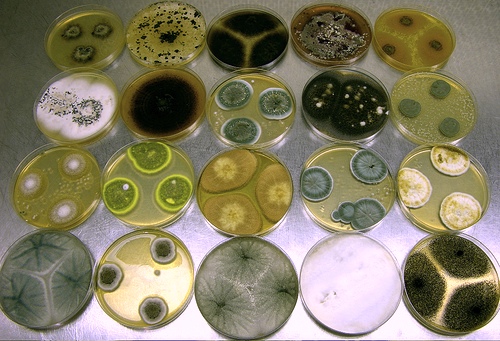Exposure to mold has been associated with exacerbation of asthma symptoms in children.
In this study from Ohio, the risk of asthma at the age of 3 years was defined by an Asthma Predictive Index (API). Visible mold was evaluated by means of home inspection.
(1-3)-beta-D-glucan is one of the major structural components of fungi, the levels were measured in settled dust.

Various fungi including Penicillium and Aspergillus spp. growing in axenic culture. Image source: Wikipedia, Dr. David Midgley Cultures: Dr. David Midgley University of Sydney, Australia, Creative Commons Attribution ShareAlike 2.5 License.
Children aged 3 years with high visible mold in the home during infancy were 7 times more likely to have a positive API.
Mother's smoking was the strongest significant risk factor for the future development of asthma.
The authors concluded that the presence of visible mold and mother's smoking during infancy were the strongest risk factors for a positive API at the age of 3 years.
Mold exposure during infancy as a predictor of potential asthma development. Iossifova YY, Reponen T, Ryan PH, Levin L, Bernstein DI, Lockey JE, Hershey GK, Villareal M, LeMasters G. Ann Allergy Asthma Immunol. 2009 Feb;102(2):131-7.
In this study from Ohio, the risk of asthma at the age of 3 years was defined by an Asthma Predictive Index (API). Visible mold was evaluated by means of home inspection.
(1-3)-beta-D-glucan is one of the major structural components of fungi, the levels were measured in settled dust.

Various fungi including Penicillium and Aspergillus spp. growing in axenic culture. Image source: Wikipedia, Dr. David Midgley Cultures: Dr. David Midgley University of Sydney, Australia, Creative Commons Attribution ShareAlike 2.5 License.
Children aged 3 years with high visible mold in the home during infancy were 7 times more likely to have a positive API.
Mother's smoking was the strongest significant risk factor for the future development of asthma.
The authors concluded that the presence of visible mold and mother's smoking during infancy were the strongest risk factors for a positive API at the age of 3 years.
Regarding the mold/asthma link, certain findings have been found consistently: 1. the mold has to be visible, 2. the mold has to be in the room where they live, 3. the patient does not have to be allergic to mold to have symptoms because the some molds release irritant volatile compounds in the air.
Asthma Predictive Index (API) (modified)
Children under 3 years of age who had 4 or more episodes of wheezing in the past year that lasted more than 1 day and affected sleep are significantly likely to have persistent asthma after the age of 5 years if they also have either:
1. one of the following:
- parental history of asthma
- a physician diagnosis of atopic dermatitis
- evidence of sensitization to aeroallergens
OR
2. two of the following:
- evidence of sensitization to foods
- greater than 4% peripheral blood eosinophilia
- wheezing apart from colds

Modified Asthma Predictive Index (API) (click to enlarge the image).
References:
Asthma Predictive Index (API) (modified)
Children under 3 years of age who had 4 or more episodes of wheezing in the past year that lasted more than 1 day and affected sleep are significantly likely to have persistent asthma after the age of 5 years if they also have either:
1. one of the following:
- parental history of asthma
- a physician diagnosis of atopic dermatitis
- evidence of sensitization to aeroallergens
OR
2. two of the following:
- evidence of sensitization to foods
- greater than 4% peripheral blood eosinophilia
- wheezing apart from colds
Modified Asthma Predictive Index (API) (click to enlarge the image).
References:
Mold exposure during infancy as a predictor of potential asthma development. Iossifova YY, Reponen T, Ryan PH, Levin L, Bernstein DI, Lockey JE, Hershey GK, Villareal M, LeMasters G. Ann Allergy Asthma Immunol. 2009 Feb;102(2):131-7.
The Asthma Predictive Index: A very useful tool for predicting asthma in young children. Jose A. Castro-Rodriguez. JACI, 2010.
In Scotland, passage of smoke-free legislation was associated with 18% decrease in asthma hospitalizations per year http://goo.gl/6LdK
In Scotland, passage of smoke-free legislation was associated with 18% decrease in asthma hospitalizations per year http://goo.gl/6LdK
The Asthma Predictive Index: Not a useful tool in clinical practice. J Allergy Clin Immunol. 2010.
Smoke-free laws reduce asthmatic symptoms http://goo.gl/K1U5h
Exposure to visible mold and/or dampness during first 2 years of life associated with asthma risk - but odds ration (OR) was very close to 1.0. Allergy, 2011.
Immunotherapy to molds - the only two molds which have been studied extensively are Alternaria and Cladosporium http://buff.ly/VkpH8Y
Immunotherapy to molds - the only two molds which have been studied extensively are Alternaria and Cladosporium http://buff.ly/VkpH8Y